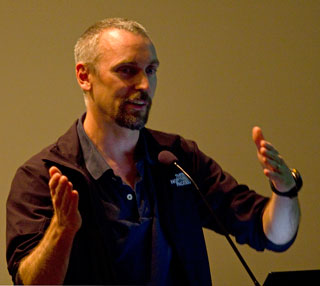Cartwright documents one-third of life with art
Stephen Cartwright said he has always had a love for 3D art since he was a child making paper airplanes.
Cartwright, a professor at the University of Illinois, gave a lecture about his art exhibit that he created from wind chimes and plexi glass.
About 40 students and faculty gathered in the Tarble Arts Center Wednesday night after looking over Cartwright’s art exhibit. Cartwright’s biggest piece in the exhibit, “Light 2007,” gained a lot of attention.
He created this piece made out of chimes by first recording the local times from sunrise to sunset from 1999 to 2007 no matter where he was in the world. The chimes were longer representing longer days and shorter when the days were short.
One of Cartwright’s first pieces was, “Intersection.” He recorded on a map every elderly woman he saw from 1996-1999.
Cartwright said his family is very supporting of his art, but they reacted better to his latitude and longititude project than “Intersection.”
Cartwright started the latitude and longitude project over 12 years ago. He took his hand held GPS everywhere he went and recorded his latitude and longitude every hour. Once he recorded his data, he documented it on an Excel graph. Cartwright said there was a time where he tried to take a break from recording.
“I got all itchy,” he said. “So I had to keep doing it.”
Cartwright has created many 3D art pieces from his latitude and longitude projects. In 1998, Cartwright said he spent a lot of time thinking of human boundaries, which influenced his piece, “Off Surface.”
“Off Surface,” is a 3D model of a bike with airplane wings.
The piece, Cartwright said, represents breaking free from earthly bounds.
Many of Cartwright’s pieces are taken from his bike and running tours where he still records his latitude and longitude. After coming back from a trip to Europe, he created “2006 Elevator,” which is a typographic generator that can form different landscaping.
Allie Pavelich, a junior art education major from U of I, traveled to Eastern to see Cartwright’s work. Cartwright was Pavelich’s former professor.
“I remember seeing him recording every hour and riding his bike, but I had no idea he would make a sculpture out of that,” Pavelich said.
The newest pieces, the “Mesh” series, are Cartwright’s favorite. They are also the only colorful pieces. Cartwright said he only colored these pieces to differentiate them from his other works.
Jonathan Massullo, a graduate art major, said Cartwright’s use of physical art interested him.
Cartwright said he has recorded one third of his life.
“My art serves as a external memory for me and my family,” Cartwright said.
Cartwright documents one-third of life with art

Stephen Cartwright talks to an audience about his sculptures that were inspired by lattitude and longitude at the different places he visited every day on Wednesday night in the Tarble Arts Center. (Jordan Boner





































































